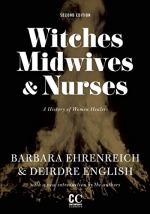|
This section contains 887 words (approx. 3 pages at 400 words per page) |

|
Witches, Midwives, and Nurses Summary & Study Guide Description
Witches, Midwives, and Nurses Summary & Study Guide includes comprehensive information and analysis to help you understand the book. This study guide contains the following sections:
This detailed literature summary also contains Topics for Discussion on Witches, Midwives, and Nurses by Barbara Ehrenreich.
The following version of the book was used to create this study guide: Ehrenreich, Barbara and Deidre English. Witches, Midwives, and Nurses: A History of Women Healers. Feminist Press, 2010. Second Edition.
The 2010 edition of Witches, Midwives, and Nurses: A History of Women Healers (WMN) opens with a new introduction by the authors. This introduction contextualizes the original manuscript, written in the 1970s, and updates some of the authors’ initial assertions based on more recent scholarship. It explains the political and social context which drove Ehrenreich and English to pen the original manuscript and presents their hypothesis that women have been systematically disempowered when it comes to both their traditional roles as healers and their understanding of their own bodies. The introduction also explains the lack of scholarship which was available to the authors in the 1970s as well as the contribution their treatise made to the development of feminist scholarship as a legitimate academic field. Despite the necessary corrections they make to their original text based on this more recent scholarship, the authors maintain the contemporary relevance of their research as the American healthcare system is still profit-driven.
The original introduction to WMN asserts that women have historically always been healers and asks how they, as a gender, arrived at their current position of subservience in the healthcare industry from a historical position of leadership. The authors argue that this transition was the result of an active takeover by male professionals which sought to suppress female healers in a political, gendered, and classist struggle.
In the first main section of the book, Ehrenreich and English examine how women healers in Europe were suppressed in the early Modern era. First and foremost, through systematic witch hunts which targeted them, and second through the creation of a male medical profession which was supported by the ruling classes. The authors demonstrate how the base misogyny of the Church was used to support the argument that female peasant healers, operating without Church approval, got their healing powers from consorting with the Devil. On the other-hand, male healers of higher-class status who operated within Church-sanctioned methods, where doing the work of God. The power to heal, as demonstrated by female lay-healers was inherently a challenge to the will of God who had made the patient sick in the first place. Furthermore, should God wish to intervene on behalf of a patient, he would only do so through a male intermediary, according to Christian dogma. Thus, the argument that female healers are working with the Devil was intensified. At the same time, women were excluded from newly founded universities which trained male practitioners, thus making it impossible for women healers to gain “legitimate” status in the professionalization of healthcare. While both witch hunts and the exclusion of women from universities failed to eliminate the female lay-healer and midwife, the resulting cultural ethos was one that associated these female practitioners with an aura of superstition and malevolent that has lasted through the ages.
In the United States, the male takeover of healthcare did not occur until the nineteenth century. Up until then, the combination of frontier life and a lack of formal universities in the country meant that healing roles fell to the most capable person, regardless of gender. Ehrenreich and English argue that the male takeover of the profession in the nineteenth century is a result of a broader class and gender struggle in which the male professionals were able to secure financial and institutional support. The rise of the male medical professional occurred at the same time that formal medical training began to gain ground in the United States. Once again, this formal training was primarily open only to middle-class men who then used their training as a way to discredit all other practitioners. Although this idea was resisted by the people during the Popular Health Movement of the 1830s and 1840s, the dominant male practitioners eventually won out. This is due to two main factors. First, the male practitioners and their institutions were given significant financial support by philanthropic foundations emerging at the time such as the Carnegie and Rockefeller foundations. Second, coincidently advances in scientific knowledge made formal medical training more necessary and women were once again excluded from institutions of higher learning. Most of the institutions which were open to women and people of color, were soon closed due to a lack of philanthropic funding, with foundation dollars going almost exclusively to universities and institutions catering to the white, male, and middle-class population.
Toward the end of this second section, the authors then discuss how this male dominance in the healthcare industry led to the rise of nursing as a “female” profession. They focus on how the divide between nurses and doctors create a gendered stratification in the industry which further reinforces sexist stereotypes about men and women.
In the conclusion, Ehrenreich and English assert that there is no historical basis for the exclusion of women from healing roles and that women have historically been active in medicine. Furthermore, they emphasis that it is a sexists and classist social system, combined with a male-monopoly of scientific knowledge that keeps women disempowered. In their final paragraph, they make a point to emphasis that female oppression as health workers in “inextricably linked” to the oppression of women in general (102).
Read more from the Study Guide
|
This section contains 887 words (approx. 3 pages at 400 words per page) |

|



